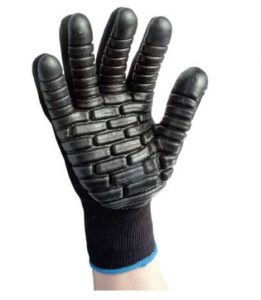 Powered hand tools are common in manufacturing (and other) work environments. Unfortunately, heavy users are at a greater risk of injury due to the transmission of vibration to a body area. To combat the negative effects, many turn to anti-vibration gloves. The abundance of products to choose from claim to be ISO certified. While some may technically meet those standards, current research shows that the standards aren’t as reliable as once thought. The testing standard for anti-vibration gloves, ISO 10819, only requires five subjects be tested. Combine that with the varied position of which those subjects hold the handle accelerometer, inter-subject variability occurs (Budd & House, 2017).
Powered hand tools are common in manufacturing (and other) work environments. Unfortunately, heavy users are at a greater risk of injury due to the transmission of vibration to a body area. To combat the negative effects, many turn to anti-vibration gloves. The abundance of products to choose from claim to be ISO certified. While some may technically meet those standards, current research shows that the standards aren’t as reliable as once thought. The testing standard for anti-vibration gloves, ISO 10819, only requires five subjects be tested. Combine that with the varied position of which those subjects hold the handle accelerometer, inter-subject variability occurs (Budd & House, 2017).
The current ISO standard for anti-vibration gloves requires that testing only be performed on the transmissibility of vibration to the palm and not the fingers. When tested, many gloves were only effective in reducing vibration to the palm within a certain range of frequency. Furthermore, some of these gloves tended to increase transmissibility of vibration to the fingers. An added downside to their use is the notable reduction in grip strength, with some gloves causing a reduction as high as 41%, creating a whole host of potential new issues (Hamouda et al., 2018).
When it comes to personal protective equipment (PPE), employers sometimes buy the latest and greatest products in an attempt to keep their employees safer and free from injuries. Anti-vibration gloves can increase comfort, but they should not be relied on as a fundamentally safe form of PPE. When it comes to protecting employee health and well-being, it’s best to implement strategies that reduce exposure time and invest in tools with low levels of vibration.
Vendors: Cestus, Honeywell, Impacto Protective Products
Sources: Budd, D., & House, R. (2017). Examining the Usefulness of ISO 10819 Anti-Vibration Glove Certification. Annals of Work Exposures and Health, 61(2), 137-140. Hamouda, K., Rakheja, S., Dewangan, K., & Marcotte, P. (2018). Fingers’ vibration transmission and grip strength preservation performance of vibration reducing gloves. Applied Ergonomics, 66, 121-138.
